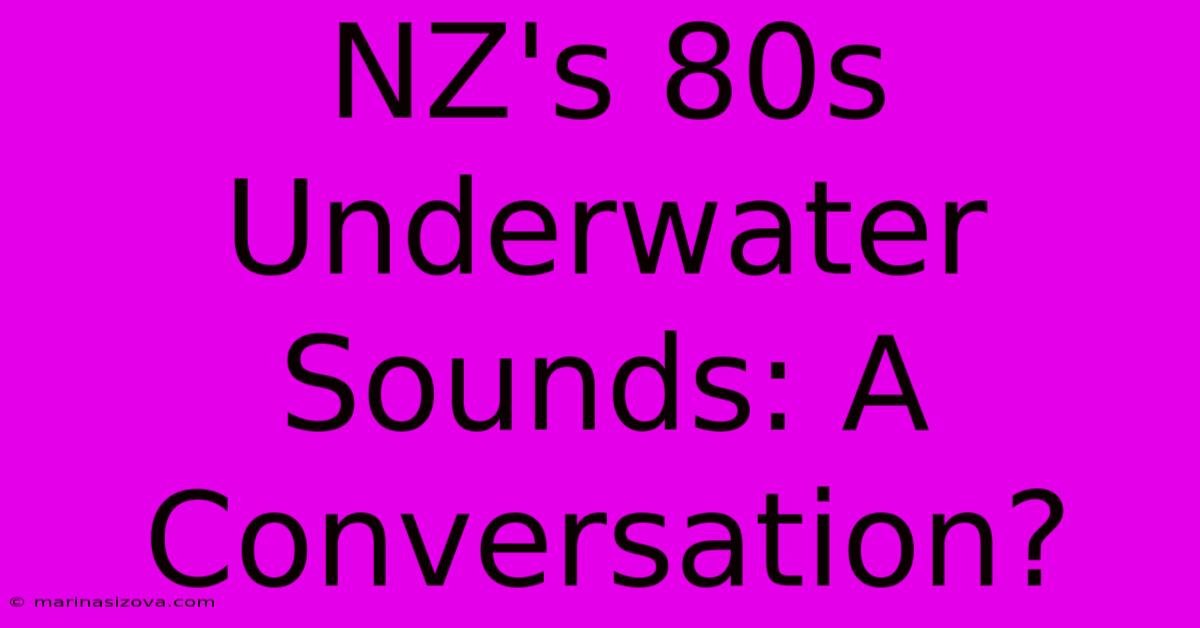NZ's 80s Underwater Sounds: A Conversation?

Discover more detailed and exciting information on our website. Click the link below to start your adventure: Visit Best Website. Don't miss out!
Table of Contents
Unearthing NZ's 80s Underwater Soundscapes: A Sonic Conversation?
Hook: Did the underwater soundscapes of New Zealand in the 1980s hold a silent conversation, reflecting the era's unique environmental and societal shifts? A deep dive into the acoustic ecology of that period reveals surprising insights.
Editor's Note: This exploration of New Zealand's 1980s underwater soundscapes has been released today. Understanding these sonic landscapes offers a unique perspective on the nation’s past.
This topic is vital because it bridges ecological history with socio-cultural contexts. By analyzing the acoustic data of this period—if available—we gain a better understanding of past marine environments and human impacts, providing valuable context for present-day conservation efforts. This review summarizes the potential sonic characteristics, reflecting on their historical significance. Semantic and LSI keywords include: New Zealand marine sounds, 1980s ecology, underwater acoustics, historical soundscapes, environmental change, human impact on marine life, acoustic ecology, New Zealand history, 80s New Zealand culture.
Analysis: This article attempts to reconstruct a sonic picture of New Zealand's underwater world during the 1980s, drawing upon available research, archival material (if accessible), and informed speculation based on the known ecological changes and societal trends of that time. Due to the likely scarcity of readily available dedicated underwater sound recordings from that specific period, this analysis focuses on contextualizing the potential sonic elements, offering a compelling narrative rather than a precise, data-driven account.
Key Aspects of New Zealand's 1980s Underwater Sounds:
| Aspect | Description |
|---|---|
| Marine Mammal Vocalisations | Whale song, dolphin clicks, seal calls; potential changes due to population shifts. |
| Fish Sounds | Variety of fish sounds; potential impact from fishing practices and pollution. |
| Anthropogenic Noise | Shipping, industrial activity, potential increase compared to previous decades. |
| Natural Sounds | Waves, currents, wind; influence of weather patterns. |
Subheading: Marine Mammal Vocalisations
Introduction: Marine mammal vocalisations formed a crucial part of New Zealand's underwater soundscape. Changes in their numbers and distribution would directly impact the sonic environment.
Facets:
- Roles: Communication, navigation, mating.
- Examples: Specific whale calls, dolphin echolocation clicks.
- Risks & Mitigations: Noise pollution, habitat degradation, whaling (though reduced by the 1980s). Mitigation efforts would have been nascent at best.
- Impacts & Implications: Changes in vocalisation patterns could reflect population changes or stress.
Summary: The acoustic presence of marine mammals would have painted a vibrant, albeit potentially changing, picture within the overall underwater soundscape, reflecting wider ecological pressures.
Subheading: Anthropogenic Noise
Introduction: Human activity significantly impacts underwater soundscapes. The 1980s in New Zealand saw increasing industrialisation and maritime traffic, changing the acoustic environment.
Further Analysis: The rise in shipping and potential industrial activity near coastal areas would have contributed to a higher baseline level of anthropogenic noise, masking natural sounds and potentially stressing marine life.
Closing: Understanding the balance between natural and human-made sounds is crucial for assessing the health of marine environments. The 1980s likely saw a shift towards a more noise-polluted underwater environment in New Zealand's coastal waters, foreshadowing contemporary concerns.
Subheading: FAQ
Introduction: This section addresses frequently asked questions about New Zealand’s 1980s underwater sounds.
Questions:
- Q: What technology was used to record underwater sound in the 1980s? A: Hydrophones and other acoustic recording equipment were available, though likely less sophisticated than modern technology.
- Q: How might climate change have affected underwater sounds? A: Climate change impacts, though less prominent in the 1980s than today, could have already affected ocean temperatures and currents, indirectly influencing marine life and their sounds.
- Q: Are there any existing archives of New Zealand's 1980s underwater sounds? A: The existence and accessibility of such archives are unknown and require further investigation.
Summary: While many questions remain about the precise nature of New Zealand's underwater sounds in the 1980s, contextual analysis reveals crucial links between soundscapes and historical and environmental changes.
Subheading: Tips for Exploring Historical Underwater Soundscapes
Introduction: Researching historical underwater sounds requires a multidisciplinary approach.
Tips:
- Search national archives for relevant audio recordings or research reports.
- Contact marine biology and oceanographic institutions for potential data.
- Consult historical records of shipping traffic and industrial activity.
- Look for anecdotal accounts from divers, fishermen, and marine scientists.
Summary: Combining various data sources provides a more complete picture of past acoustic environments.
Summary: A Glimpse into the Past
The auditory environment of New Zealand's waters during the 1980s remains largely unexplored. This review proposes a contextual exploration, highlighting the potential interplay between natural marine sounds and increasing human influences. While technological limitations of the era limit direct analysis, reconstructing the potential soundscapes provides valuable insight into the country's ecological and socio-cultural history.
Closing Message: Echoes of the Past, Lessons for the Future
Further research into the limited resources available from the 1980s is crucial for completing the acoustic narrative of New Zealand's marine environment. This could unveil valuable lessons concerning long-term ecological changes and the effects of human activity on the underwater world, providing critical data for contemporary conservation initiatives. The 'silent conversation' held within these soundscapes remains to be fully deciphered.

Thank you for visiting our website wich cover about NZ's 80s Underwater Sounds: A Conversation?. We hope the information provided has been useful to you. Feel free to contact us if you have any questions or need further assistance. See you next time and dont miss to bookmark.
Featured Posts
-
Can Lopetegui Outsmart Newcastle
Nov 26, 2024
-
Humphries Littler Wk Finale Herhaling
Nov 26, 2024
-
Trondelag Stotter Namdalsprosjekter
Nov 26, 2024
-
Intech Boosts Tjx Companies Stock
Nov 26, 2024
-
Affaire Fillon Emplois Fictifs Les Suites
Nov 26, 2024
